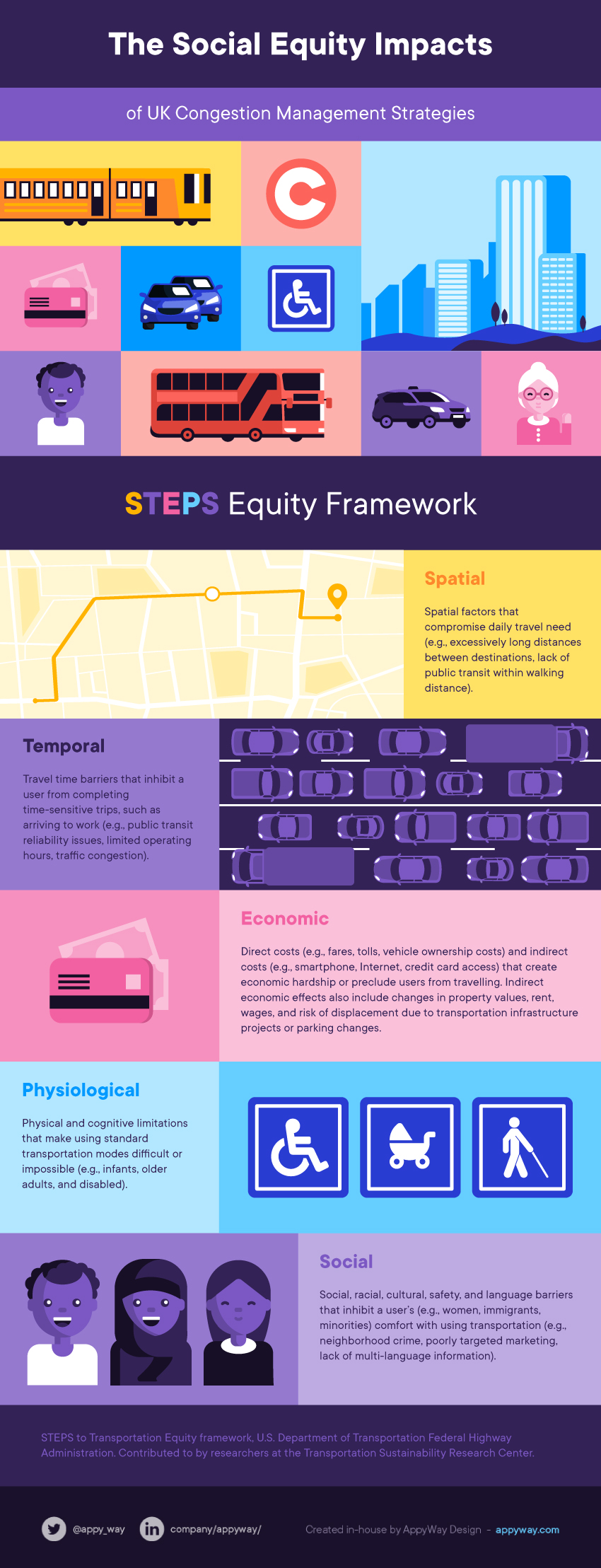In December last year, Susan Shaheen, Adam Stocker, Ruth Meza from the Transportation Sustainability Research Center at UC Berkeley published a white paper analysing the social equity impacts of different congestion management strategies. For local authorities and cities tasked with reducing air pollution and congestion, this is a key assessment of how different approaches will impact their citizens beyond the number of vehicles on the road.
The different methods are assessed according to the STEPs Equity Framework (below) and include road pricing, kerb and parking policies, infrastructure changes, operational strategies such as public transit improvements, transportation strategies, and taxation.

All the methods assessed are found to have a mix of positive and negative social equity impacts, and often require a mixed approach to produce a more positive result. Car free areas, for example, still need to be accessible by delivery vans and those with disabilities to avoid negative economic and physiological impacts, a topic which we tackled in more detail here.
Most measures will also need to be combined with investment in modal shift and public transport to avoid having a negative impact on access.
What about the UK?
The authors’ analysis primarily focuses on the USA, which is more reliant on cars than in the UK, even in many major cities. Parallels exist, however, especially outside of major cities with good public transport. Overall, traffic speeds have declined across the UK over the last decade, while congestion has increased by 14% within UK cities in this same time period, according to DfT figures. Air quality has also degraded, leading to the order to implement Clean Air Zones (CAZ) in cities including Birmingham, Leeds, Portsmouth, and Oxford. These factors alone have detrimental effects on physiological, economic, and temporal barriers listed in the STEPS Equity Framework. Yet solutions for raising air quality and countering congestion must also avoid exacerbating existing, or creating new unintended barriers.
Across the UK, congestion management strategies continue to be planned and implemented, from the Park and Ride facilities north of the Forth Road Bridge to cycling highways in Manchester, while York has announced intentions to make the city centre car free. Ensuring there are no unintended negative consequences across the STEPs Equity Framework is key. For example, many authorities, especially in Wales and Scotland, will need to include accessibility for those in rural areas alongside those in currently underserved urban areas.
Congestion in the capital
Even London, which has implemented many of the different strategies including road pricing, infrastructure changes such as cycle superhighways, and public transport investment, still has huge issues with social equity in terms of access to public transport for those in poorer areas, with disabilities, as well as access to safe cycling, green spaces, and services.
The congestion charge, now 17 years old, is one flagship example used worldwide. Director of LSE London, Professor Tony Travers has claimed: “London has achieved the impossible by eradicating the private car – and still having desperate traffic congestion”.
London has come a long way, but once you balance the travel needs and desires of all 8 million residents for leisure, accessing services, and making a living, that means there are still buses, bicycles, delivery vans (up 25% in the past decade), vehicles supplying construction materials, taxis, and Uber drivers fighting for space on the roads, to name but a few. What’s more, not all areas are well served by public transport (especially in South London), and some still rely on private cars despite efforts to the contrary. Meeting everyone’s needs is a complex task.
Through all this, however, the authors identify kerbside management as one of the most positive methods for managing congestion, as it reduces or eliminates barriers for spatial, temporal, physiological and social issues. According to the paper, effective kerbside management can reduce obstructions to public transit and bicycles, reduce congestion if more can access active and public transit, increase access for those with disabilities, and facilitate the introduction of other uses such as parklets, which can improve health and wellbeing. Those on low incomes may also benefit as they are often more likely to need to use public transport.
At AppyWay, our goal is to facilitate management of the kerb to enable intelligent, sustainable mobility for all. Armed with best-in-class kerbside data, APIs and full stack management systems, we know kerbs are our key to tackling urban issues of modern-day living: congestion, mobility, pollution, even dying high streets, and welcome the opportunity to help local authorities to meet these goals.
Click here for more information on shared mobility and transport equity by the U.S Dept. of Transport and the FHWA.






